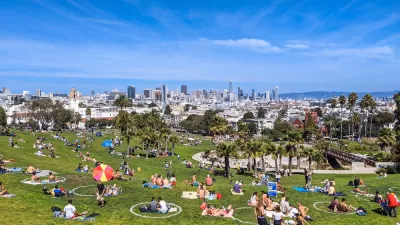Three examples of problem solving and "catalytic action" can help San Diego with its I.D.E.A. District, writes former SPUR director Jim Chappell.
In the East Village area of San Diego, some property owners have a "big idea" for a creative and high tech incubator district. In fact, they're calling it the I.D.E.A. District. I.D.E.A. stands for Innovation Design Education Arts. The East Village has seen some tremendous investment and redevelopment in the past two decades, but pockets of the area continue to lag.
This summer, the San Diego Architectural Foundation held a series of workshops culminating in a panel discussion, titled Context2 - What's the Big Idea? Jim Chappell, former Director of the San Francisco Planning and Urban Research Association (SPUR) was one of the panelists. In an article just published, he recaps his presentation. He gives three examples in San Francisco where, despite best laid plans, revitalization did not occur until an area presented a solution to a pressing problem. He called this "catalytic action." The examples Chappell provided as examples:
Yerba Buena Gardens
Despite the construction of the convention center, this area of SOMA remained essentially a desert until the San Francisco Museum of Modern Art, in need of a new home, took advantage of redevelopment offerings and relocated there.
Mission Bay
Multiple plans for the former rail freight yard land in SOMA owned by Catellus were mired when Mayor Willie Brown, hoping to prevent UCSF Medical School from relocating outside of the city, convinced Catellus to donate 30 acres of its 300 acres to UCSF for a new medical school. The school was built, which catalyzed other related development in the area.
"Twitter Zone"
San Francisco's Central Market neighborhood remained seedy despite several efforts and high expectations for revitalization. In 2011, Twitter was considering relocating outside of the City due to San Francisco’s 1.5% payroll tax. Chappell explains what happened next:
[T]he San Francisco Supervisors passed the Central Market Payroll Tax Exclusion, more popularly known as the "Twitter Tax Break." It’s a simple law that is basically a tax holiday until 2018 within a prescribed Central Market Area. No Redevelopment Area; no Comprehensive Plan; not even a General Plan. Just a tax law.
Under the law, a business pays 1½% payroll tax on the lesser of its payroll its first year in business or its actual payroll. It does not have to pay tax on additional payroll (including those stock options) for six years. This exclusion expires in 2018 (eight years from passage) by which time San Francisco’s payroll tax will be completely replaced by a gross receipts tax.
As a result, Twitter stayed in San Francisco, and numerous other business moved into the Central Market area, accompanied by residential development and restoration of historic buildings.
Chappell's message to San Diego: while catalytic redevelopment can be unpredictable, posture the I.D.E.A. District to solve a problem. In this post-redevelopment California, consider using the Enhanced Infrastructure Financing District law, effective January 1, 2015, to help make the area a problem solver.
FULL STORY: Setting the I.D.E.A. District Apart

Maui's Vacation Rental Debate Turns Ugly
Verbal attacks, misinformation campaigns and fistfights plague a high-stakes debate to convert thousands of vacation rentals into long-term housing.

Planetizen Federal Action Tracker
A weekly monitor of how Trump’s orders and actions are impacting planners and planning in America.

San Francisco Suspends Traffic Calming Amidst Record Deaths
Citing “a challenging fiscal landscape,” the city will cease the program on the heels of 42 traffic deaths, including 24 pedestrians.

Defunct Pittsburgh Power Plant to Become Residential Tower
A decommissioned steam heat plant will be redeveloped into almost 100 affordable housing units.

Trump Prompts Restructuring of Transportation Research Board in “Unprecedented Overreach”
The TRB has eliminated more than half of its committees including those focused on climate, equity, and cities.

Amtrak Rolls Out New Orleans to Alabama “Mardi Gras” Train
The new service will operate morning and evening departures between Mobile and New Orleans.
Urban Design for Planners 1: Software Tools
This six-course series explores essential urban design concepts using open source software and equips planners with the tools they need to participate fully in the urban design process.
Planning for Universal Design
Learn the tools for implementing Universal Design in planning regulations.
Heyer Gruel & Associates PA
JM Goldson LLC
Custer County Colorado
City of Camden Redevelopment Agency
City of Astoria
Transportation Research & Education Center (TREC) at Portland State University
Jefferson Parish Government
Camden Redevelopment Agency
City of Claremont





























